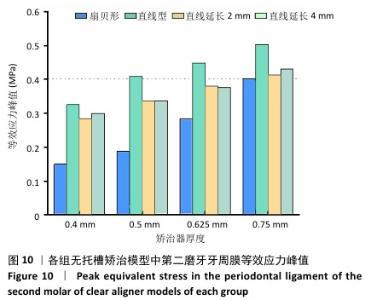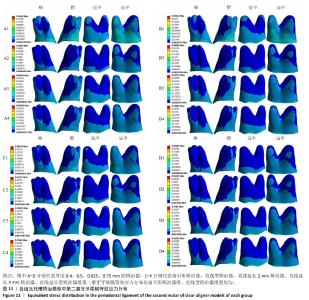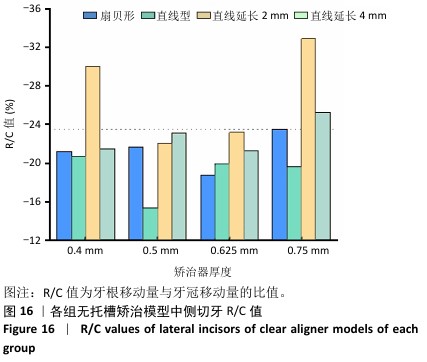[1] GAO M, YAN X, ZHAO R, et al. Comparison of pain perception, anxiety, and impacts on oral health-related quality of life between patients receiving clear aligners and fixed appliances during the initial stage of orthodontic treatment. Eur J Orthod. 2021;43(3):353-359.
[2] ROSSINI G, PARRINI S, CASTROFLORIO T, et al. Efficacy of clear aligners in controlling orthodontic tooth movement: a systematic review. Angle Orthod. 2015;85(5):881-889.
[3] 谢贤聚.无托槽隐形矫治技术推磨牙向远中的机制与优势[J].中国实用口腔科杂志,2019,12(8):459-463.
[4] 赖文莉.无托槽隐形矫治技术推磨牙向后的临床应用策略[J].国际口腔医学杂志,2019,46(4):373-382.
[5] CARUSO S, NOTA A, EHSANI S, et al. Impact of molar teeth distalization with clear aligners on occlusal vertical dimension: a retrospective study. BMC Oral Health. 2019;19(1):182.
[6] SIMON M, KEILIG L, SCHWARZE J, et al. Treatment outcome and efficacy of an aligner technique--regarding incisor torque, premolar derotation and molar distalization. BMC Oral Health. 2014;14:68.
[7] 程钰迅,金作林,马艳宁,等.无托槽隐形矫治生物力学研究进展[J].中华口腔正畸学杂志,2022,29(3):169-172.
[8] SEO JH, EGHAN-ACQUAH E, KIM MS, et al. Comparative Analysis of Stress in the Periodontal Ligament and Center of Rotation in the Tooth after Orthodontic Treatment Depending on Clear Aligner Thickness-Finite Element Analysis Study. Materials (Basel). 2021;14(2):324.
[9] ELSHAZLY TM, KEILIG L, SALVATORI D, et al. Effect of trimming line design and edge extension of orthodontic aligners on force transmission: An in vitro study. J Dent. 2022;125:104276.
[10] HO CT, HUANG YT, CHAO CW, et al. Effects of different aligner materials and attachments on orthodontic behavior. J Dent Sci. 2021;16(3): 1001-1009.
[11] LI X, REN C, WANG Z, et al. Changes in force associated with the amount of aligner activation and lingual bodily movement of the maxillary central incisor. Korean J Orthod. 2016;46(2):65-72.
[12] ELSHAZLY TM, BOURAUEL C, ALDESOKI M, et al. Computer-aided finite element model for biomechanical analysis of orthodontic aligners. Clin Oral Investig. 2023;27(1):115-124.
[13] ELKHOLY F, MIKHAIEL B, REPKY S, et al. Effect of different attachment geometries on the mechanical load exerted by PET‑G aligners during derotation of mandibular canines : An in vitro study. J Orofac Orthop. 2019;80(6):315-326.
[14] ELSHAZLY TM, BOURAUEL C, CHAVANNE P, et al. Numerical biomechanical finite element analysis of different trimming line designs of orthodontic aligners: An in silico study. J World Fed Orthod. 2024;13(2):65-71.
[15] 雷鹤,陶洪,罗晶,等.不同Ⅱ类牵引模式对无托槽隐形矫治磨牙远移作用的比较:三维有限元研究[J].中华口腔正畸学杂志,2021, 28(3):152-156.
[16] 雷鹤,高冲,吴冬雪,等.隐形矫治磨牙远移的三维有限元分析[J].口腔医学,2021,41(8):692-698.
[17] 范典,刘浩,袁长永,等.无托槽隐形矫治器力学性能的影响因素及研究进展[J].口腔医学,2023,43(3):278-281.
[18] COWLEY DP, MAH J, O’TOOLE B. The effect of gingival-margin design on the retention of thermoformed aligners. J Clin Orthod. 2012;46(11): 697-702,705.
[19] KIM TW, ECHARRI P. Clear aligner: an efficient, esthetic, and comfortable option for an adult patient. World J Orthod. 2007;8(1): 13-18.
[20] KOHDA N, IIJIMA M, MUGURUMA T, et al. Effects of mechanical properties of thermoplastic materials on the initial force of thermoplastic appliances. Angle Orthod. 2013;83(3):476-483.
[21] LYU X, CAO X, YAN J, et al. Biomechanical effects of clear aligners with different thicknesses and gingival-margin morphology for appliance design optimization. Am J Orthod Dentofacial Orthop. 2023;164(2): 239-252.
[22] ELSHAZLY TM, SALVATORI D, ELATTAR H, et al. Effect of trimming line design and edge extension of orthodontic aligners on force transmission: A 3D finite element study. J Mech Behav Biomed Mater. 2023;140:105741.
[23] BARONE S, PAOLI A, RAZIONALE AV, et al. Computational design and engineering of polymeric orthodontic aligners. Int J Numer Method Biomed Eng. 2017;33(8):e2839.
[24] TRAVERSA F, CHAVANNE P, MAH J. Biomechanics of clear aligner therapy: Assessing the influence of tooth position and flat trimline height in translational movements. Orthod Craniofac Res. 2024. doi: 10.1111/ocr.12796.
[25] QIAN Y, FAN Y, LIU Z, et al. Numerical simulation of tooth movement in a therapy period. Clin Biomech (Bristol, Avon). 2008;23 Suppl 1:S48-S52.
[26] LIU JQ, ZHU GY, WANG YG, et al. Different biomechanical effects of clear aligners in bimaxillary space closure under two strong anchorages: finite element analysis. Prog Orthod. 2022;23(1):41.
[27] BOZKAYA E, TORTOP T, YUKSEL S, et al. Evaluation of the effects of the hybrid Pendulum in comparison with the conventional Pendulum appliance. Angle Orthod. 2020;90(2):194-201.
[28] VILANOVA L, HENRIQUES J, PATEL MP, et al. Class II malocclusion treatment changes with the Jones jig, Distal jet and First Class appliances. J Appl Oral Sci. 2020;28:e20190364.
[29] 刘妍.无托槽隐形矫治临床应用的优势与不足[J].中华口腔医学杂志,2017, 52(9):538-542.
[30] SUN W, XIA K, HUANG X, et al. Knowledge of orthodontic tooth movement through the maxillary sinus: a systematic review. BMC Oral Health. 2018;18(1):91.
[31] 何梦佳,周宇,王思婕,等.无托槽隐形矫治器推上颌磨牙远移的效率及影响因素研究进展[J].口腔医学,2022,42(9):851-855.
[32] ELKHOLY F, WEBER S, REPKY S, et al. Are aligners capable of inducing palatal bodily translation or palatal root torque of upper central incisors? A biomechanical in vitro study. Clin Oral Investig. 2023;27(8):4289-4300.
[33] SIMON M, KEILIG L, SCHWARZE J, et al. Forces and moments generated by removable thermoplastic aligners: incisor torque, premolar derotation, and molar distalization. Am J Orthod Dentofacial Orthop. 2014;145(6):728-736.
[34] PUTRINO A, BARBATO E, GALLUCCIO G. Clear Aligners: Between Evolution and Efficiency-A Scoping Review. Int J Environ Res Public Health. 2021;18(6):2870.
[35] ELSHAZLY TM, BOURAUEL C, ALDESOKI M, et al. Effect of attachment configuration and trim line design on the force system of orthodontic aligners: A finite element study on the upper central incisor. Orthod Craniofac Res. 2024. doi: 10.1111/ocr.12779.
[36] ELSHAZLY TM, NANG D, GOLKHANI B, et al. Effect of thermomechanical aging of orthodontic aligners on force and torque generation: An in vitro study. J Mech Behav Biomed Mater. 2023;143:105911.
[37] GOLKHANI B, WEBER A, KEILIG L, et al. Variation of the modulus of elasticity of aligner foil sheet materials due to thermoforming. J Orofac Orthop. 2022;83(4):233-243.
[38] JINDAL P, JUNEJA M, SIENA FL, et al. Mechanical and geometric properties of thermoformed and 3D printed clear dental aligners. Am J Orthod Dentofacial Orthop. 2019;156(5):694-701. |















